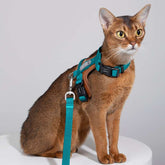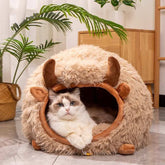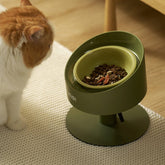Understand Your Cat's Tail Language

Your cat says one thing, but you might have guessed it's something else. Tail movement and tail positions are how cats and dogs express themselves. When interpreting what our pets are trying to say, keeping the situation in mind is crucial. And while some physical cues are common in both cats and dogs, they don't always signify the same thing, and comprehending the differences is essential to understand your pet's needs better.
Twitching
When cats are hunting or playing, or when they are moderately irritated or frustrated, they twitch the tips of their tails. Now is a good time to observe for other clues about their mood and what causes their annoyance. The twitching tail movement indicates that they might be aggravated if they aren't playing or stalking anything.
Swishing
If your cat is slowly swishing their tails from side to side, it's probably getting ready to strike a target - which could be a toy, another animal in the house, or anything that is moving (like a shadow!). Allowing your cat to indulge in predatory behavior such as stalking and pouncing satisfies its natural instincts. It releases stress and keeps them well-exercised; just make sure it's safe and your furry friend is not trying to attack another human in the house.

Quivers
When your cat is particularly eager to meet you or another cat, its tail may quiver. Urine marking might occur when a cat shakes its tail, holding it straight up while backing up against a vertical surface.
Held Low
If a cat is scared or concerned, it may lower its tail below the level of its back. If your cat's tail is tucked between the legs, they are either terrified or feeling discomfort.
Thrashing
If you're petting your cat and it starts thrashing its tail, it's a way of telling you to stop immediately. It could also be a warning sign that hissing, growling, swatting, or a bite is on the way. This is a strong signal that your cat is furious, annoyed, or angry, and you should stay away from further interaction with your pet.
Body Curled
When your cat sits or lies down with their tail wrapped around its body, it means they are scared, defensive, in pain, or unwell. When you see this, stop interacting with your cat and make sure your cat's environment is stress-free. If it lasts for more than a few days, there might be something causing your cat's pain, and it's time for a vet visit.

Fluffed Up
With a fluffed-up tail, your cat wants to appear bigger and stronger, and is a defensive reaction that indicates your cat wants to be left alone. It could be Feeling intimidated by other animals in the yard, approaching dogs, visitors in the house, or any abrupt noise. Reduce your cat's tension by removing the provoking sources. Make sure you and your family members stay away from your pet as it might be feeling extremely agitated and aggressive.
Stands Straight with a curly tip
When a cat's tail is up, it indicates that it is gregarious, feeling confident, and approachable. This signifies the ideal moment to pet or play with your cat.
























